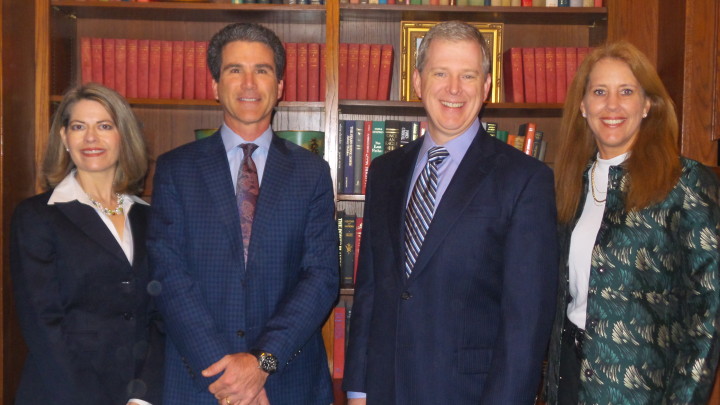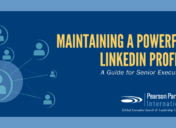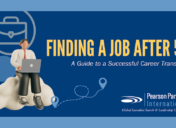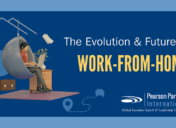Texas on the Fast Track

From L to R: Renee Arrington, Keith Pearson, Tim Keith, Holly Reed
With Texas on a rapid growth trajectory, our roadways are growing ever more congested, making it harder for travelers to get where they need to go. The state has long examined high-speed rail as an alternative to driving or flying across the state, but none of the proposed systems have gained traction—until now. A private company, Texas Central, is planning America’s first bullet train line, speeding between Dallas/Fort Worth and Houston and set to open within seven years.
For Pearson Partners’ Q1 2016 Spotlight SeriesSM breakfast, we invited Texas Central’s chief executive officer Tim Keith and managing director of external affairs Holly Reed, to explain what makes Texas the perfect market for high-speed rail and provide an update on the project’s progress to date.
The Need for Speed
As one of the fastest-growing states in America, Texas needs new ways to reduce congestion and efficiently move people across the state. More than 1,000 people move to Texas every day, and North Texas and Houston are the fastest-growing regions in the state, both on track to double their size in the next two to three decades. The growing strain on highway infrastructure is expected to increase travel times by 30 to 35 percent over the next 20 years.
The new high-speed rail project, slated for completion by 2021, is a historic chance to change the future of Texas.
The brainchild of a private company, Texas Central Partners, LLC, the train will speed travelers from North to South Texas at about 200 miles an hour, taking riders the 240 miles between Dallas/Fort Worth and Northwest Houston in less than 90 minutes. Trains are projected to run every 30 minutes during peak times and every hour off-peak and will also serve a Brazos Valley Station in Grimes County.
Project leaders say that this high-speed rail system will give Texans more choices, and will be the most efficient way to move the most people, with the least amount of impact on the environment. Designed to complement airline travel, rather than compete with it, the rail system is expected to relieve highway congestion by taking millions of people off the highways between DFW and Houston.
Not as susceptible to weather or traffic delays as travel by car or airplane can be, trains are expected to speed passengers to their destination predictably and within one minute of their scheduled arrival time. Ticket prices will be affordable—competitive with airlines and similarly segmented by market and demand.
The technology is the same as the highly successful, proven and safe Japanese bullet train, the Shinkansen N700. The technology has been adapted for use in the United States, including meeting all requirements for the Americans with Disabilities Act. Each 11-foot-wide car will have wide aisles, spacious 2×2 seats and Wi-Fi, allowing travelers to work as they travel. The Japanese trains have run successfully for more than 50 years with no injuries or fatalities due to operations.
Getting Up to Speed
A multi-year environmental impact study is underway, examining the project’s impact on communities, land, agriculture and wildlife, and helping to pinpoint the ideal corridor. The planned route will run parallel to existing utility lines, with much of the track constructed on elevated viaducts allowing free movement of people and animals. No public roads will be closed.
While the private company developing the railroad system is allowed to use eminent domain, it is instead choosing to work with ranchers and communities. The team is hosting open houses in the communities, talking to landowners, listening to their needs and striving to build a system that works for them.
Regulatory approvals are under way, and two leading construction companies have partnered to put their time and cash at risk and provide a fixed-price, firm-date contract.
Once in place, the new railroad infrastructure will promote ongoing economic development in Texas by connecting people, information and goods. The system will create about 1,000 permanent jobs all along the line, as well as 10,000 each year during the four years of construction. All capital will be invested in Texas, with hard costs for the infrastructure, controls and signaling expected to be about $10 billion.
It is the first project of its kind, in which private equity is helping to fund public service and public infrastructure. To date, Texas Central Railway has closed $75 million in private equity funding, with 17 Texas families investing in shaping the future of the state. The rest of the needed capital will come from other global sources, including pension markets, Japanese banks and U.S. federal credit programs.
The project will spur about $36 billion in economic impact in its first 20 years of operation through employment, supply purchases and ticket sales. In the same time period, the rail system is expected to generate $2.5 billion in tax revenues in state sales tax, sales and use tax to local communities, and ad valorem tax to the various districts the rail line will pass through on its way across the state.
To receive updates about the progress of the Texas Central Railway high-speed rail project, text the word “RAIL” to 52886.
Pearson Partners Spotlight SeriesSM Breakfast
Save the date for our next Spotlight SeriesSM breakfast scheduled for June 7. Look for details and invitations in May. Did you miss one of our Spotlight SeriesSM events? Check out summaries of past events.














